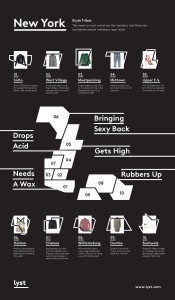The data anaLYSTs have taken over the fashion website – Lyst.com

Lyst is a data- and analytics-driven business that offers users an easier, streamlined way to discover and shop 1000s of products and provides retailers with a wealth of customer insights – and a better conversion rate.
Overview
Lyst is a social curation and commerce site founded in 2010 by Chris Morton (CEO and a former VC), Devon Hunt (currently a partner at Founder Centric) and Sebastjan Trepca (CTO and a software engineer). Lyst’s app and website allow people to browse and purchase products from over 9000 designers and 2000 stores and create wishlists of items. The company drives sales through a highly data-driven approach, generating personalized recommendations for users based on their preferences, shopping history, and customer profile. The company also uses data insights to create ‘lysts’ to help users discover and shop current trends. As of November 2015, Lyst has 40 million customers, over 2 million unique visitors per month, sales of $150 million and an inventory of 3 million pieces.
Operating Model
Lyst’s founders were inspired by Spotify and sought to aggregate and personalize fashion products similar to how the music streaming service does with songs. The company sees itself first and foremost as a technology firm and in 2014, 50% of Lyst’s employees were data scientists. Its operating model is designed to use data analytics to design a superior customer experience and thereby increase sales.
“We have 3 million products on our site, 40 million annual shoppers, we generate hundreds of millions of dollars in sales but we don’t ever touch any products,” said Joanna Christie, head of brand and communications at Lyst. “We are a data company – we crunch 4.5 million data points every hour. That gives us a huge amount of insight.”
Value Creation
Lyst creates value for consumers by aggregating products from 1000s of different brands and stores and generating personalized recommendations for each user. In doing so, it provides consumers with an easier, less noisy buying experience. Typically, online shoppers visit multiple e-commerce websites from big department stores to small boutiques and scan pages of products in the hopes of finding something they like, maybe copy-pasting links into a Word document for reference and to compare features and prices. Instead, Lyst users receive curated recommendations based on their style profile and can browse 1000s of products from different e-commerce retailers on a single site. And, importantly, using Lyst’s universal shopping basket, they can buy items directly from the retailer without leaving the Lyst website.
Lyst creates value for retailers by sharing with them the platform’s wealth of data insights. Lyst’s leading team of data scientists break down the consumer data and share it with sellers in an organized fashion – a key reason why leading retailers are keen to partner with the site. Retailers can use information about their own brand to predict demand and better understand their customers’ buying patterns, but they can get similar information from their own e-commerce sites. Lyst tracks and shares consumer data across brands, which offers retailers something new. For example, Lyst knows that red clothes have the highest return rate of all colors as do purchases made on a Monday versus any other day of the week. The company has a blog post comparing New York and London buying patterns here and just launched a tongue-in-cheek ad campaign that highlights its data-driven business model. Lyst also recently released an infographic showing popular purchases by New York City neighborhood:

Value Capture
Lyst makes money from affiliate links, i.e. a commission from retailers for sales made via Lyst.com. Around 2012, the company analyzed its data and found that when it directed shoppers to a brand’s website to make a purchase, users often abandoned their shopping cart out of boredom or frustration. According to Founder and CEO Morton, the quality of a partner’s checkout experience could result in as much as a 10% difference in conversion rates. As a result, Lyst built a ‘universal shopping cart’ so customers could purchase items from multiple brands in a single order without leaving the site. This required complex back end engineering to sync checkout processes and inventory levels. Morton says that the streamlined checkout has increased conversion by over 200% for some brands.
Interestingly, Lyst has chosen to give away its data analytics and integrate its platform with retailers’ for free, likely part of the company’s strategy to scale its two-sided platform and grow internationally.
Looking ahead
Lyst is an impressive, emerging e-commerce player with 300% year-on-year sales growth in the past three years. It is currently ahead of social curation and commerce peers like Polyvore, Keep, and Spring because of its technological and analytical prowess and resulting superior user experience. Its universal shopping cart is a major competitive advantage. However, two major challenges could derail Lyst’s promising trajectory:
Instagram and Pinterest enter shoppable curation: Both social media giants recently launched shoppable pins and posts, and now compete directly with social commerce sites like Lyst. While Lyst’s shopper experience is likely superior, both tech giants have the advantage of their enormous user bases to mine data insights and drive revenue – even with a lower conversion rate, they can win on volume. Lyst’s ability to attract new users and retain existing ones is likely to be challenged as a result.
Universal shopping cart – winner takes all: Lyst has created a best-in-class universal shopping cart for its site. In the future, it is likely that one white-label shopping cart will emerge as the standard across all e-commerce sites. Social platforms with huge user bases, e.g. Facebook or Pinterest, a financial software firm, e.g. PayPal or Apple Pay, or a large e-commerce platform, e.g. Amazon, could all enter this space and threaten Lyst, even as Morton explores a white-label product.
I think Lyst’s focused, UX-driven approach stands a fighting chance. As you ponder the future of e-commerce, check out this awesome visualization of Lyst data here.



I really like Lyst’s universal shopping cart and the concept of personalized fashion. I wonder how they are able to personalize the choices they show you. Is it based on items you purchased or clicked on to get a better view but didn’t purchase? If you bought a Rag and Bone sweater, do they show you more sweaters, more Rag and Bone products, or more winter gear? It is probably a combination of all of these factors plus others like your age and if you live on the east coast vs. west coast, etc. I’m sure Lyst doesn’t disclose this type of proprietary information but its interesting to think about what drives the personalization. The current shopping experience is so broken, if Lyst is able to get the personalization right, I think they could have real potential.
As you say, the threat of big companies like Google and Facebook building a universal shopping cart into their platform is very real and looming. Especially concerning is that retailers would probably prefer to work with Facebook because they can always be a click away from perusing your friends’ photos and finding that dress you really want. If I have to go to another site to start shopping, my impulses are harder to capture and impulse buys are especially big for fashion.
Agreed – it is really unclear how one company will be able to differentiate itself from the pack. And if it’s about data, quantity of available data will matter and Lyst may not be the best one in that field.